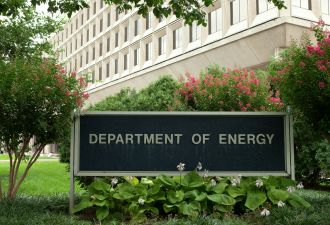The Federal Energy Regulatory Commission has issued an order that could allow mid-Atlantic grid operator PJM to restart its capacity auction, the country's biggest, by mid-2021 after a two-year delay.
But FERC’s order will still force state-subsidized resources to use administratively set minimum prices that could bar them from clearing PJM’s market, a fact that’s led states and clean energy and environmental groups to bring court challenges against FERC.
The commission’s sole Democratic member warned that new changes imposed by FERC’s Republican majority to PJM’s plan to comply with its order could pose problems for longstanding state programs that secure generation capacity, including renewables.
Thursday’s order closely matches the PJM compliance plan for meeting FERC’s minimum offer price rule, or MOPR, for its roughly $10 billion per year capacity market. Under that plan, offshore wind farms will almost certainly be priced out of the market, but state-subsidized onshore wind, solar power, nuclear power and demand-side resources may be able to win approval for bids low enough to clear.
FERC Chairman Neil Chatterjee, a Republican, said the rule will “advance competitive, transparent markets.” FERC’s Republican majority has passed successive MOPR orders in 2018 and 2019 on the grounds that state subsidies distort capacity prices and undermine the nonsubsidized fossil-fuel-fired generators that make up most of the market today.
Richard Glick, the commission’s sole Democrat since mid-2019, has opposed these orders, and others that have imposed minimum prices on state-backed clean energy resources in New York capacity markets, on the grounds that they constitute an attempt to undermine state clean energy goals.
At Thursday’s FERC meeting, Glick criticized Chatterjee’s assertion that the MOPR rule was meant to promote competition, saying, “The only thing the commission is promoting is byzantine administrative pricing.”
“The states are getting increasingly restless as they see the commission blocking their efforts,” Glick added. “Everyone can see where this will lead, and it’s not a pretty picture.”
Several states in PJM’s 11-state footprint have proposed removing themselves from its capacity market over fears that the MOPR rule will undermine their clean-energy and carbon-reduction goals.
That list includes New Jersey and Maryland, which have major offshore wind plans, and Illinois, which has carbon-free energy plans and nuclear power plants struggling to stay open. New York regulators are also considering different options for securing grid capacity resources.
Chatterjee defended FERC’s MOPR rule in a Thursday press conference, noting that clean energy resources, “if given the chance to compete, will thrive” without state subsidies. He also repeated his view that states won’t exit PJM’s capacity market, highlighting the “value for consumers, for the economy and for the environment” that the market provides.
Carbon pricing and distributed energy market access as alternatives
Chatterjee also highlighted several FERC decisions seeking to create more market-based opportunities for clean energy resources, including the potential for grid operators to create market rules that incorporate state carbon-pricing regimes. FERC held a technical conference last month on the topic and on Thursday issued a proposed policy statement declaring its authority under federal law to consider such rules.
That’s not a guarantee that FERC will approve the carbon-pricing plan from New York state grid operator NYISO or others being considered by grid operators that manage transmission networks that provide electricity to about two-thirds of the country.
But it does offer “confidence that those proposals will not be a dead letter on our doorstep” and that FERC will “recognize the benefits that such proposals, if properly designed, could bring to our markets,” Chatterjee said.
FERC’s Orders 841 and 2222, which open up wholesale energy market participation to energy storage resources and distributed energy aggregations, respectively, could also open up more opportunities, he said. “That market-driven approach to me is the smart and right way to protect consumers [and] the environment, and drive economic growth.”
But Glick disputed this view in Thursday’s meeting. While he affirmed his support for the orders Chatterjee referred to, Glick told the chairman, “You cannot trumpet support of these new technologies in one moment, and turn around and [subject them to the] MOPR...the next,” he said.
Uncertainty on the terms and timing of the next PJM capacity auction
One major implication of FERC’s order is that it starts the clock on PJM’s pledge to restart its capacity auctions within six and a half months, Chatterjee said. PJM has been forced to delay its annual auctions for the past two years while it awaited FERC guidance and approval for the new MOPR structure, a problem for generators that rely on capacity market revenue, as well as for an industry that relies on market prices to determine the value of future investments.
“Auction outcomes are essential for competitive power suppliers to make investment decisions, retire uneconomic assets and continue to provide least-cost, efficient generation to help ensure there is enough power available to meet reliability needs even during peak demand,” said Todd Snitchler, CEO of the Electric Power Supply Association generator group, in a Thursday statement. Solar and wind power trade groups also support a quick resumption of the auction.
But PJM’s auction plans will have to wait for another FERC decision regarding its energy and ancillary services markets, Chatterjee noted. That’s because that decision will impact the pricing structures that go into setting MOPR default offer price floors for different resources, meaning that “some pre-auction activities cannot be conducted until we issue our next order.”
“We’re working as swiftly as possible on that front,” he said, and didn’t provide a date for its resolution.
Poison pill for states with default service auctions and renewable portfolio standards?
Meanwhile, FERC’s order asked PJM to make some changes to its compliance plan in the next 30 days. Those include at least one change that Glick noted could threaten the viability of “default service” auctions, which organize how utilities secure generation resources in states with deregulated energy markets.
FERC’s April ruling indicated that default service auctions including resources procured under state renewable portfolio standard programs could be subjected to MOPR mitigation. Thursday’s order seeks to clarify that issue by describing how “non-discriminatory or fuel-neutral” auctions can avoid that.
But Glick said that “whatever help the commission may offer to PJM was taken away by a footnote,” referencing the fact that New Jersey’s basic generation service auction may trigger MOPR mitigation.
Chatterjee declined to clarify how that footnote would guide PJM’s treatment of New Jersey’s auction or other state default service auctions in Thursday’s press conference. He did say that the text of the order, which had not been published as of midday Thursday, “speaks for itself” on that matter.




